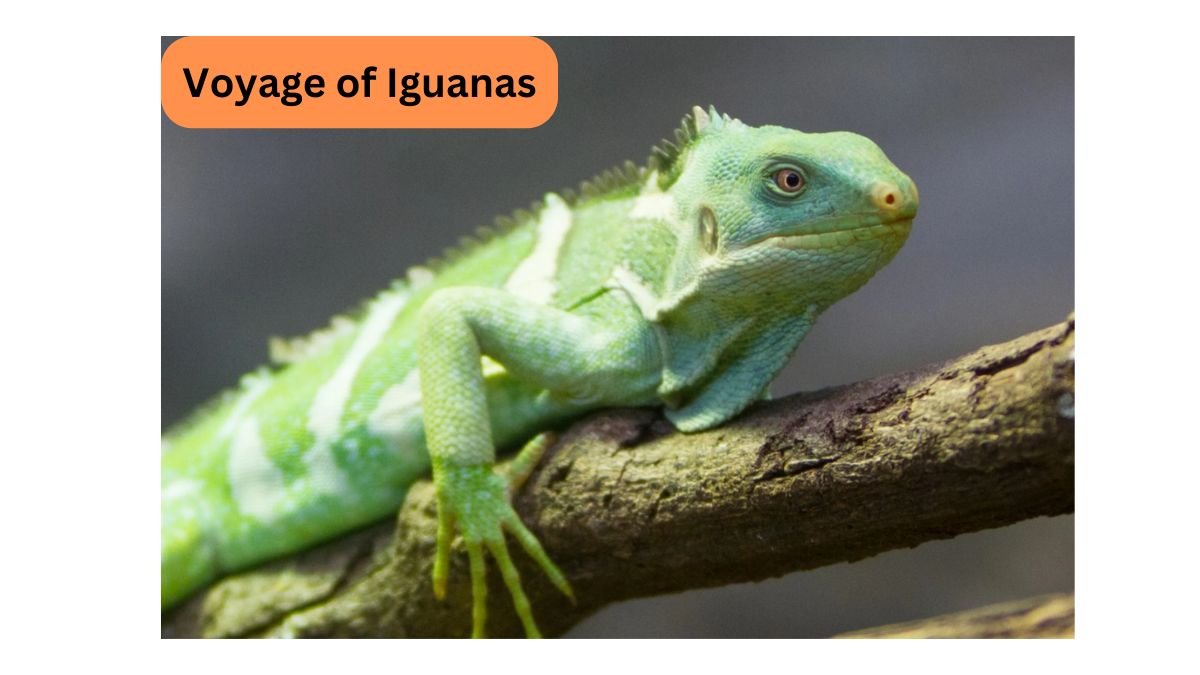Iguanas are typically found in the Americas, ranging from the southwestern United States to the Caribbean and parts of South America.
However, the presence of iguanas on the remote islands of Fiji and Tonga in the South Pacific has puzzled scientists for decades.
How did these reptiles, native to such distant regions, make their way to these isolated islands?
A groundbreaking study published recently sheds light on this mystery, providing surprising insights into how these reptiles may have arrived in the South Pacific.
The Surprising Journey: Over 8,000 Kilometers Across Open Ocean
In a study published in the Proceedings of the National Academy of Sciences, Simon G. Scarpetta, an evolutionary biologist from the University of San Francisco, and his team have proposed a compelling theory: the ancestors of the iguanas on Fiji may have crossed the ocean on mats of floating vegetation.
This journey, covering nearly 8,000 kilometers of open ocean, would be the longest-known voyage ever undertaken by a non-human vertebrate.
While the idea of long-distance travel by floating debris, known as “rafting,” is not new, it has typically been observed in smaller creatures like insects or marine organisms.
These smaller creatures can survive long periods afloat, but the idea of larger vertebrates, such as iguanas, undertaking such a lengthy voyage seemed nearly unimaginable.
Rafting: A Long-Standing Phenomenon for Small Creatures
Rafting refers to the process where animals hitch a ride across oceans on uprooted trees or mats of plants.
While this form of travel is common among small invertebrates, it is much rarer among vertebrates.
Lizards, however, have been known to travel longer distances on rafts, possibly due to their slower metabolism, which allows them to survive for extended periods without food.
For example, in 1995, scientists observed at least 15 green iguanas rafting more than 300 kilometers on hurricane debris between Caribbean islands.
The ancestors of Galápagos iguanas are also believed to have made the 1,000-kilometer journey from South America to the Galápagos Islands on floating vegetation.
However, the idea of iguanas crossing the vast South Pacific remains a much more daunting challenge.
Timing the Journey: When Did the Iguanas Arrive in the South Pacific?
To understand how iguanas could have made their way to the Pacific Islands, Scarpetta’s team analyzed the genetics of the Fijian iguana species, which belongs to the genus Brachylophus.
The team compared genetic samples from 14 different iguana species to trace the evolutionary history of the Fijian iguanas and determine when their closest relatives diverged.
Genetic Evidence: The Link Between Fijian and Desert Iguanas
The study revealed that the closest living relatives of the Fijian iguanas are the desert iguanas of the genus Dipsosaurus, which are found in the American Southwest and northwestern Mexico.
The genetic analysis indicated that Brachylophus and Dipsosaurus split around 30 to 34 million years ago, providing a key clue to the iguanas’ journey.
The Importance of Timing: Ice Age Conditions and the Formation of the Islands
This timing is crucial in understanding the iguanas’ migration. Around 30 million years ago, the Fijian archipelago began to form, but the Earth was also undergoing a period of extreme cold, with ice around the poles.
These harsh conditions would have made it impossible for any iguana species to travel over land from the Americas to Asia or Australia, and then cross to the Pacific Islands.
Given this, the researchers concluded that the most plausible explanation for the iguanas’ arrival in Fiji is overwater rafting, as land-based migration was not a viable option at the time.
Overwater Rafting: How Did They Survive the Long Journey?
The study also provides evidence to suggest that the iguanas’ journey was not just possible but probable.
A three- to four-month journey across the ocean would have coincided with the iguanas’ natural hibernation period.
This would have allowed them to survive the long voyage without the risk of starvation. Additionally, traveling on floating vegetation would have provided the herbivorous iguanas with a steady food supply, further increasing their chances of survival.
How Rafting Helped Iguanas Thrive
Rafting provided several advantages for the iguanas. First, the floating vegetation would have served as a habitat, offering some protection and a means of sustaining themselves during the journey.
Secondly, the slow metabolism of reptiles like iguanas meant they could survive without food for extended periods, making the long trip more manageable.
The vegetation would also have served as a constant source of food, further aiding their survival.
Implications for Evolution: The Role of Long-Distance Dispersal
The study by Scarpetta and his colleagues has significant implications for our understanding of evolutionary biology.
The researchers’ findings contribute to a growing body of evidence suggesting that long-distance dispersal—traveling vast distances across oceans—is far more important in the evolutionary history of many animal species than previously appreciated.
Reevaluating Evolutionary History
Hamish G. Spencer, an evolutionary geneticist at the University of Otago, praised the study for shedding light on the crucial role that long-distance dispersal has played in the evolutionary history of animal groups.
This research demonstrates how species have adapted to survive challenging environments and have found innovative ways to travel across large distances, often leading to the colonization of new habitats.
Conclusion: Solving the Mystery of the Iguanas’ Journey
In conclusion, the mystery of how iguanas arrived on the remote islands of Fiji and Tonga is gradually being solved.
The rafting theory provides a plausible explanation for their journey across the South Pacific, offering new insights into the remarkable survival strategies of these reptiles.
This discovery not only advances our understanding of iguana evolution but also highlights the broader significance of long-distance dispersal in shaping biodiversity.
The study of how these iguanas navigated such vast distances opens up new avenues for research into animal migration and survival across the globe.
This study marks an exciting milestone in evolutionary biology, offering a fresh perspective on how species can traverse seemingly insurmountable barriers and adapt to new environments.








